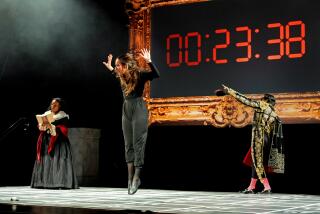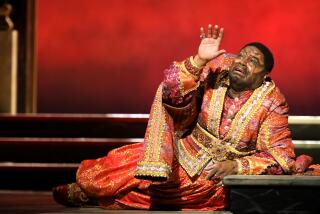They filmed the opera ‘Vireo’ on Alcatraz. Soon you can stream it on your iPad or phone
In composer Lisa Bielawa’s world, cows sing, a ponytailed man plays the hurdy-gurdy in the backseat of a vintage Chrysler Valiant and an escape from Alcatraz is as simple as tossing a knotted sheet rope out a prison cell window and driving off into the night — to Sweden.
Bielawa’s new opera, “Vireo: The Spiritual Biography of a Witch’s Accuser,” is unlike any you have seen before, in content and in form. Filmed in the historic San Francisco penitentiary (now part of the Golden Gate National Recreation Area) as well as other locations in the Bay Area, Southern California and New York over three years, “Vireo” is believed to be the first major opera project to be packaged episodically for digital distribution.
For the record:
1:51 p.m. April 25, 2024An earlier version of this article reported that “Vireo” developed out of research that composer Lisa Bielawa conducted as a graduate student at Yale. She was an undergraduate.
KCET acted as a creative partner in “Vireo” and will release all 12 episodes online on May 31. The station also will air the episodes back-to-back locally on TV and nationally on satellite (via Link TV) as part of a special 2½-hour “Artbound” presentation June 13.
Translating a live performative art into something that can be binge-watched Netflix-style via computer, tablet or phone requires innovative thinking, so the diverse, boundary-breaking members of the “Vireo” creative team were an asset.
Composer Bielawa has been working at the edge of possibility for years. In 2013, she brought together more than 800 professional and amateur musicians as part of her “Crissy Broadcast,” transforming San Francisco’s Crissy Field into a living, breathing musical soundscape.
That experience proved useful in making the “Vireo” episode filmed inside Alcatraz. Like Crissy Field, the island’s facilities are overseen by the National Park Service. The contacts and permitting processes for both projects were essentially the same.
“We really went in Alcatraz through the front door,” Bielawa said, adding that the experience of “Vireo” producer Marnie Burke de Guzman also was essential. In 2015, Burke de Guzman led the team that produced artist and activist Ai Weiwei’s exhibition “@Large: Ai Weiwei on Alcatraz.”
Once they were in the door, filming on Alcatraz presented unusual challenges and rewards. The acoustics of the former prison amplified the vocal ensemble’s sound magnificently. But the film team couldn’t lean anything against a wall or use any tape on the floor. The crew also had to bring all of its own power generators for the complex shoot, and sound engineers had to work around wireless mikes that could not transmit through the thick concrete of cell block walls.
Director Charles Otte said the biggest challenge to filming on Alcatraz was a universal one: limited time. But he also said that limitations prompt creativity.
With a career in theater, opera, TV, film and gaming, Otte has frequently found himself at the intersection of creativity and new technology. For this project, he decided that the best approach would be to insert the viewer directly into the action.
“Early on, I decided there was no point in playing it safe,” he said. “There is no reason for us not to take chances and make this a piece that breaks rules.” He shot every episode using a single camera (gimbal, Steadicam or hand-held) and inserted the musicians inside the action, placing them prominently throughout each set and including them in shots alongside the actors.
That reality changed the way Bielawa composed her score.
“I was aware when I was writing the music that the camera might be right up on a cello,” she said. “So I was fascinated by that visual of the physicality of playing an instrument. It changed the way I wrote. I think it brought the instrumentation forward texturally.”
The story of “Vireo” is compelling and cryptic. The piece delves into the psyche of a young woman who experiences extreme visual and auditory hallucinations. It’s a trippy, surrealist world where a woman in black-and-white cow print pajamas stands in a barn behind a table covered in an assortment of milks and cheeses, and, with a cowhide draped over her shoulders and pink plastic utters protruding from her stomach, looks into a camera and sings — the seriousness of her rich, controlled alto tone contrasting sharply with her outlandish costume.
“Vireo” developed out of research Bielawa conducted as an undergrad at Yale in the 1990s, when she became fascinated by micro-histories of young women across the centuries who experienced hysterical fits and the men (often doctors, priests and psychologists) who tried to understand or “cure” them. Erik Ehn wrote the poetic, dense libretto. Kronos Quartet was part of a long list of musicians to perform on the project.
Like Hulu’s adaptation of Margaret Atwood’s “The Handmaid’s Tale,” the story of “Vireo” feels eerily pertinent today. The female gaze here is strong, effectively revealing the ugliness of patriarchal oppression as older men seek to control a young woman, poking, prodding and imprisoning her.
In a grand display of of female power, opera veteran Deborah Voigt brings Wagnerian grandeur to Episode 11 as the Queen of Sweden. But it is a rising star, Rowen Sabala, who owns this show.
SIGN UP for the free Essential Arts & Culture newsletter »
Sabala, who sings the title role, is a compelling young soprano who graduated from the Orange County School of the Arts in May 2016 and is studying vocal performance at Drake University in Des Moines.
Sabala’s technical ability to navigate Bielawa’s dense, atonal score is matched by her skill in communicating intimate emotion on-screen. Ultimately, it is her youthful abandon and connection to the role –– she was 16 when filming of “Vireo” began –– that makes the production sing.
Watching “Vireo” online feels like being onstage during a live performance. It is an immersive experience that, while developed specifically for this production, could be translated to other opera recordings, engaging with the audience more easily than a traditional video shot from the seats. That the opera can be consumed in whatever way the viewer chooses –– all at once or in bite-sized portions –– also is interesting. This is opera, testing technologies and formats as it feels its way into the 21st century.
Support coverage of the arts. Share this article.
ALSO
How SoCal became the backdrop to Lisa Bielawa’s opera about a ‘hysterical’ woman
Gustavo Dudamel dedicates concert to a slain student in Venezuela
At 24, Benjamin Grosvenor delivers virtuosity beyond his years
Diary of a world premiere: Join playwright Rajiv Joseph as the curtain rises on Archduke’
More to Read
The biggest entertainment stories
Get our big stories about Hollywood, film, television, music, arts, culture and more right in your inbox as soon as they publish.
You may occasionally receive promotional content from the Los Angeles Times.






